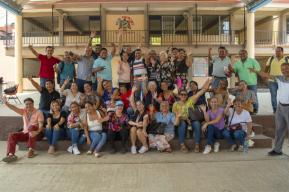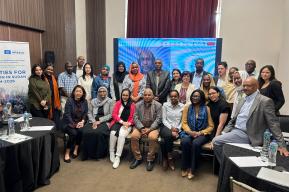News
What you need to know about the Comprehensive School Safety Framework 2022-2030

Education systems are facing more hazard-related risks than ever. In 2015, a magnitude 7.8 earthquake struck Nepal, leaving almost one million children out of school. Each year since the adoption of the Sendai Framework for Disaster Risk Reduction 2015-2030 –the United Nations’ global framework of action for risk reduction in all sectors, including education - disasters resulting from natural hazards and climate change have devastated lives and disrupted education.
Since June 2022, some 33 million people in Pakistan have been affected by historical floods. More than 1,300 lives – a third of whom children - have already been lost. In the education sector, large scale destruction of school facilities has interrupted the education of more than 3.5 million students. Approximately 22,000 schools are reported as destroyed or damaged in Sindh (by far the most affected province), Balochistan, Punjab and Khyber Pakhtukhwa.
Despite significant commitments such as the Sendai Framework’s target to substantially reduce disaster damage in the education sector by 2030, and critical initiatives like the Worldwide initiative for Safe Schools, through which 58 countries committed to be School Safety Champions as of 2019, education systems remain extremely vulnerable and are expected to become even more so in the context of the escalating climate crisis.
This is not counting the staggering impacts of the COVID-19 pandemic, which has led to the closure of schools for months - years in some cases - with unprecedented effects on children’s right to education and well-being. Sadly, the past decade has also seen an increase in the number of conflict zones, where education has been under attack… often in countries that are also deeply affected by natural hazards and climate change (e.g., Afghanistan).
Only a radical shift in ambitions could reverse such a complex situation. UNESCO, as the upcoming chair of the Global Alliance on Disaster Risk Reduction and Resilience in the Education Sector (GADRRRES) from late September 2022, taking over from UNICEF, wishes to highlight the following, calling for immediate action:
The launch of the Comprehensive School Safety Framework 2022-2030 is an opportunity for countries to renew their commitments in support of school safety
The GADRRRES launched the Comprehensive Safe School Framework (CSSF) 2022-2030 on 12 September 2022, during an online webinar moderated by Save the Children and attended by two School Safety Champions, the Ministers of Education of Indonesia and Sint Marteen, youth advocates from Barbados and Zimbabwe, and key partners supporting the right to education worldwide, including Education Cannot Wait (ECW), the Global Partnership for Education (GPE), the Global Coalition to Protect Education from Attacks (GCPEA), the Prudence Foundation and the United Kingdom’s Foreign, Commonwealth and Development Office (FCDO).
This global launch served as a call to action. Indeed, the launch of the revised CSSF is an opportunity for countries to renew their commitments towards disaster risk reduction and resilience in the education sector and learn from – and replicate - best practices in other regions. It will be followed by regional launch events from October 2022.
Background information: The CSSF, which was developed in 2012 and first revised in 2016, is the key global Framework to support disaster risk reduction and resilience in the education sector. It is accompanied by practical tools and guidance, thus providing Ministries of Education, National Disaster Management Authorities and other education stakeholders with the means to advance regional, national and sub-national school safety agendas.
The CSSF 2022-2030 differs from the previous version of the CSSF in that it is based on an all-hazard approach, meaning that it takes into account the whole range of hazards and risks facing education systems, from natural hazards, climate change, biological and health hazards (as a response to the COVID-19 pandemic), conflict and violence, as well as other everyday hazards.
The Comprehensive School Safety Framework 2022-2030 provides a clear roadmap for action, which can easily be replicated at regional and national level
Several countries across the Caribbean and the Asia-Pacific region have already fully integrated the CSSF in their Education and/or Disaster Risk Reduction (DRR) Policy Frameworks. Similar initiatives could be reproduced in other regions. As an illustration, the Caribbean School Safety Initiative (CSSI) brings Caribbean countries together around a joint roadmap based on the pillars of the CSSF. In June 2022, 19 countries renewed their commitments at the occasion of the Third Caribbean Ministerial Forum on School Safety, hosted by the Government of Sint Marteen.
Concretely, the CSSF 2022-2030 has four key components, including a cross-cutting foundation and three intersecting pillars.
Enabling systems and policies
The foundation of the CSSF 2022-2030 focuses on strengthening system-level resilience. This includes the enabling systems and policies aimed to protect the safety, health, and well-being of the entire school community; provide effective educational continuity measures; protect education sector investments; and promote a culture of safety and resilience.
Pillar 1: Safer learning facilities
Safer Learning Facilities addresses both new and existing school facilities including building safer and greener installations. For new facilities, it focuses on site-selection, design, and construction in order to ensure safety from physical, biological, chemical and social threats. For existing facilities, it focuses on the identification and prioritization of facilities for repair, retrofit, replacement or relocation, as well as on the maintenance of physical learning environments.
Pillar 2: School safety & educational continuity management
School safety management addresses equity-focused planning for children’s health, safety, and well-being for educational continuity in relation to all-hazards and risks to children and staff in the education sector. The focus is on developing anticipatory, absorptive, adaptive, and transformative capacities for resilience through meaningful participation of and accountability to affected populations.
Pillar 3: Risk reduction and resilience education
Risk reduction and resilience education focuses on those measures aimed at creating content, processes and learning opportunities for children, staff and school communities (including parents) to develop individual and community level resilience in relation to the risks they face. This includes disaster risk management, climate change, health promotion and pandemics, child protection, violence and conflict prevention, conflict resolution, strengthening social cohesion, and psychosocial well-being.







